Astro Images
Since completing Mel's altaz drive, the quality of my CCD imaging has improved. I can now track for up to a minute without guiding. Galaxies are easy targets now,
Deep Sky
My First RGB color image, Planetary Nebula M27
40 filtered 10-second integrations, stacked in Multi245 then composited in Qcolor.
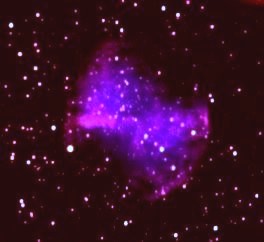
The Horsehead nebula in Orion

The Eagle Nebula, M16
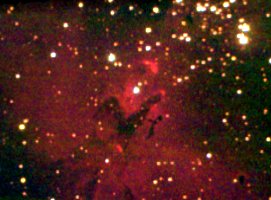
Galaxy M104, 8 15 second integrations stacked with multi245

![]() Galaxy M51, 6 10 second integrations with CB245
Galaxy M51, 6 10 second integrations with CB245

![]() Galaxy M101, 16 15 second integrations with CB245, 23k Jpg This galaxy is invisible from the light-polluted skies of Akron, Ohio, but the CCD brings it to light.
Galaxy M101, 16 15 second integrations with CB245, 23k Jpg This galaxy is invisible from the light-polluted skies of Akron, Ohio, but the CCD brings it to light.
![]() Globular cluster M13, 4 10 second integrations with CB245, 13K Jpg
Globular cluster M13, 4 10 second integrations with CB245, 13K Jpg
![]() The Great Orion Nebula, M42 & M43, 6 5-second CCD integrations on Televue Pronto 30k Jpg
The Great Orion Nebula, M42 & M43, 6 5-second CCD integrations on Televue Pronto 30k Jpg
![]() Globular cluster M92 in Hercules, 4- 5 second integrations with CB245 CCD camera on 12.5" f6 Newtonian. Using multiple exposure mode, and brutally discarding any images with trailed stars, you can overlay the images and get (almost) the equivalent of a much longer shot. To find it, if you visualize the Keystone of Hercules as a flowerpot, then M92 is the flower in the pot, centered above the wider (North) end.
Globular cluster M92 in Hercules, 4- 5 second integrations with CB245 CCD camera on 12.5" f6 Newtonian. Using multiple exposure mode, and brutally discarding any images with trailed stars, you can overlay the images and get (almost) the equivalent of a much longer shot. To find it, if you visualize the Keystone of Hercules as a flowerpot, then M92 is the flower in the pot, centered above the wider (North) end.
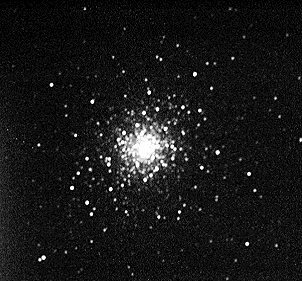
![]() Planetary Nebula, M57 in Lyra- 8 - 10 sec integrations- CB245 CCD camera on 12.5" f6 Newtonian. When an ordinary star ages and the nuclear fire goes out, the solar atmosphere drifts away, but is irradiated for a time by UV light and other radiation from the white dwarf core. M57 is the easiest planetary to find, centered between the two stars that make the small end of the triangle of the "Harp" in Lyra.
Planetary Nebula, M57 in Lyra- 8 - 10 sec integrations- CB245 CCD camera on 12.5" f6 Newtonian. When an ordinary star ages and the nuclear fire goes out, the solar atmosphere drifts away, but is irradiated for a time by UV light and other radiation from the white dwarf core. M57 is the easiest planetary to find, centered between the two stars that make the small end of the triangle of the "Harp" in Lyra.
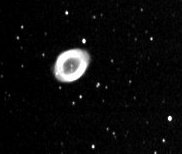
Comets
![]() Hyakutake at North pole, 23 March 1996, Kodak Royal Gold 1000, 5 minutes at f2.8, 135 mm telephoto, with tracking mount 107k Gif
Hyakutake at North pole, 23 March 1996, Kodak Royal Gold 1000, 5 minutes at f2.8, 135 mm telephoto, with tracking mount 107k Gif
![]() Hale-Bopp CCD image of nucleus, 1/2 second at prime focus of 12.5" f5 newtonian, CB245 camera 91k Gif
Hale-Bopp CCD image of nucleus, 1/2 second at prime focus of 12.5" f5 newtonian, CB245 camera 91k Gif
![]() Hale-Bopp in morning sky, Kodak Royal Gold 1000, 2 minutes at f2.8, 50 mm lens, fixed tripod. You can see the two tails. 36k Gif
Hale-Bopp in morning sky, Kodak Royal Gold 1000, 2 minutes at f2.8, 50 mm lens, fixed tripod. You can see the two tails. 36k Gif
![]() Hale-Bopp over Akron, Ohio. Kodak Royal Gold 1000, 1 minute at f2.8, 138 mm lens, fixed tripod. Even with city lights, it still looked like a comet…. Nobody has any excuse to say they didn't see it. 42k Gif
Hale-Bopp over Akron, Ohio. Kodak Royal Gold 1000, 1 minute at f2.8, 138 mm lens, fixed tripod. Even with city lights, it still looked like a comet…. Nobody has any excuse to say they didn't see it. 42k Gif
Our Moon
![]() Partial Lunar eclipse, 23 March, 1997, Kodak Royal Gold 1000, 1/2 second with 1905mm f6 telescope, fixed mount. (Love the colors) It looked like a big marble. 116k Gif
Partial Lunar eclipse, 23 March, 1997, Kodak Royal Gold 1000, 1/2 second with 1905mm f6 telescope, fixed mount. (Love the colors) It looked like a big marble. 116k Gif
![]() Planet Saturn - November 2001 - stack of 100 Sony video frames from 20"f5 with 26mm eyepiece projection
Planet Saturn - November 2001 - stack of 100 Sony video frames from 20"f5 with 26mm eyepiece projection
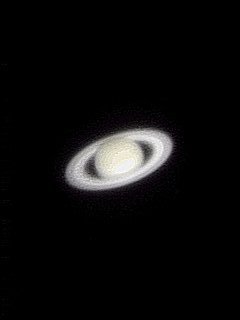
![]() Total Lunar eclipse, (1988, I think), Kodak Gold 400, series of 1 second exposures 28mm f4 lens, fixed mount. 28k Gif
Total Lunar eclipse, (1988, I think), Kodak Gold 400, series of 1 second exposures 28mm f4 lens, fixed mount. 28k Gif
Planet Jupiter
Image acquired with CB245 camera, sharpest of 24 50 millisecond exposures of Jupiter.
10.5mm Televue Plossl eyepiece projection with CB245 camera, no filter
The Great Red Spot and several festoons are visible.
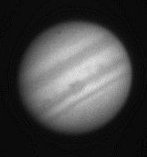
![]()